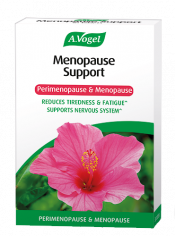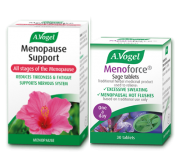Today's topic
Today on A.Vogel Talks Menopause, I'm going to be talking about five oestrogen-rich foods which are great for the menopause.
I've been asked a lot of questions about food and diet over the last few months, and I do mention certain aspects in a lot of the videos that I do. But I thought that I would use the next month to really focus on different foods that can either help or hinder you during the menopause.
So, today, it's all about foods that are rich in what's called phytoestrogens.
The role oestrogen plays during menopause
The role of oestrogen in the menopause is very important. It's a hormone that, for most of us in our fertile years, help to regulate the monthly menstrual cycle. The problem is that, when we come to the menopause, the oestrogen continues to fall.
And it's this drop that can trigger a lot of the common low oestrogen symptoms such as hot flushes and sweats, poor sleep, joint aches and pains, irritability, and mood swings.
What are phytoestrogen foods and how can they help?
 There are a number of foods that contain phytoestrogens or plant oestrogens. And what they do is they mimic the oestrogen that was in our body, they attach themselves to oestrogen receptor sites, and that then gives us a little bit of an oestrogenic boost.
There are a number of foods that contain phytoestrogens or plant oestrogens. And what they do is they mimic the oestrogen that was in our body, they attach themselves to oestrogen receptor sites, and that then gives us a little bit of an oestrogenic boost.
And doing that during the menopause can help to even out the fall of oestrogen. It can help to support our oestrogen levels, and make the symptoms less unpleasant.
Now, according to the British Dietetic Association, if you start to add plant-based oestrogen foods into your diet, this is not a quick fix. It's going to take possibly two to three months before you start to really notice any difference.
There's also the fact that the role of your friendly bacteria in your digestive tract play a huge part. Now, I've already done a link about friendly bacteria in the menopause.
It's a really important issue, so please do click on to the link at some point, and have a read of that because this in itself can make a huge difference to how you feel generally.
Foods rich in phytoestrogens
The important thing here is that, if you're going to eat these foods, you need to do it regularly. And they reckon that at least two to three times a day, every day, you need some kind of these foods in order to get the best benefit. So, what are these foods or groups of foods?
1. Soya
The first one is soya. Now, there are different forms of soya. There are what's called whole soya foods, including things like soya milk, cheese, and yoghurt, and textured vegetable protein.
I don't recommend these at all during the menopause, the reason being is that they are very difficult to digest. And a lot of women find that, when they start using them, they get the bloating. It can cause constipation, and it can cause a lot of discomfort.
If you look at the Far East where soya is a big part of the diet, the types of food you're looking at are what's called fermented soya foods. These are much easier to digest, and the plant oestrogens in them are much more readily available for our bodies to make use of.
So, you're looking at foods such as miso, tempeh, and natto. You will find most of these down at your local health food shop. So, they're not too difficult to find nowadays.
2. Seeds
The second group is seeds. These are a wonderful addition to your diet. So, it's things like linseeds, flaxseeds, sunflower seeds, sesame seeds, and pumpkin seeds.
The one thing here is, in order to be able to access the plant oestrogens, these need to be ground, not whole. Whole seeds tend to help with things like constipation. But, if you want to get the hormonal effect from them, you need to grind them.
The important thing here is that ground seeds go rancid very, very quickly. So, I use them a lot in my diet. And I have a little coffee grinder. I just buy packets of the single seeds and mix them all together. I find it's a lot cheaper that way. And then, when I want them, I just pop a couple of tablespoons into the coffee grinder, they're ground up, and I eat them straight away. You can put them in things like soups, sprinkle them on salads, or put them in smoothies.
My favourite way to have them is with yoghurt when I have yoghurt for breakfast. And I put half a teaspoon or a teaspoonful of organic cocoa powder into the mix, so I end up with lovely chocolate-flavoured yoghurt. This is a really nice treat.
3. Nuts
So, you're looking at specific nuts like walnuts. Walnuts are also great for brain function, so a couple of walnuts a day as a midmorning snack is a really great way to go.
You can also look at pistachios and peanuts. These are high-calorie, so they're not ones to munch all day. Just a small handful of peanuts, a couple of walnuts, or a small handful of pistachio nuts is enough to give you those kind of benefits.
4. Fruits
You can also look at fruits. But take these in moderation because, obviously, they're quite high in sugars. So, it's things like peaches, berries, and your dried fruit. Again, with dried fruit, you're only looking at maybe a couple of pieces a day. So, don't go overboard with those ones.
5. Pulses and beans
You can also look at your pulses and beans. So that would be things like lentils. Hummus is absolutely great too.
And you can have these in all sorts of things. You know, you can make stews or soups and put things like lentils and beans in, just as a little daily addition.
Other foods rich in phytoestrogens
And another really important one is your dark green, leafy vegetables and your fresh foods. Sprouting seeds can be another great source of plant-based oestrogen. That's things like broccoli, alfalfa, and red clover.
I sprout regularly because it just means that I've got something fresh to pick on a daily basis, especially if I run out of salads.
We do a super menopause sprouted seed pack with our BioSnacky seeds and, in that, you've got the red clover, you've got the alfalfa, you've got the broccoli, and we also include a gourmet mix as well. So, sprouting your own seeds is a super way of getting a nice daily dose of your plant-based oestrogens.
Is there a risk of consuming too many phytoestrogens?
I am often asked, "Can you overdo it with plant-based oestrogens?" It's highly unlikely. You would have to eat absolutely vast quantities, you know, practically the whole day. So, you know, for the majority of women, if you're looking at ways to supplement your oestrogen during the menopause, then adding these foods in on a daily basis is going to be nothing but beneficial.
So, I hope this has been of help for you. Next week, I'm going to focus on more beneficial foods that can be easily added into your diet without too much fuss.
What you said!
We recently ran a poll to find out which oestrogen-rich foods you are mostly likely to add to you diet or eat more of. We've crunched the numbers and here are the results.
Results: Which oestrogen-rich foods are you most likely to add to your diet or eat more of?
Nuts and seeds were the most popular oestrogen-rich foods with 28.9% saying they are most likely to add nuts to their diet or eat more of them and 24.4% saying seeds would be their preferred oestrogen-rich food.










